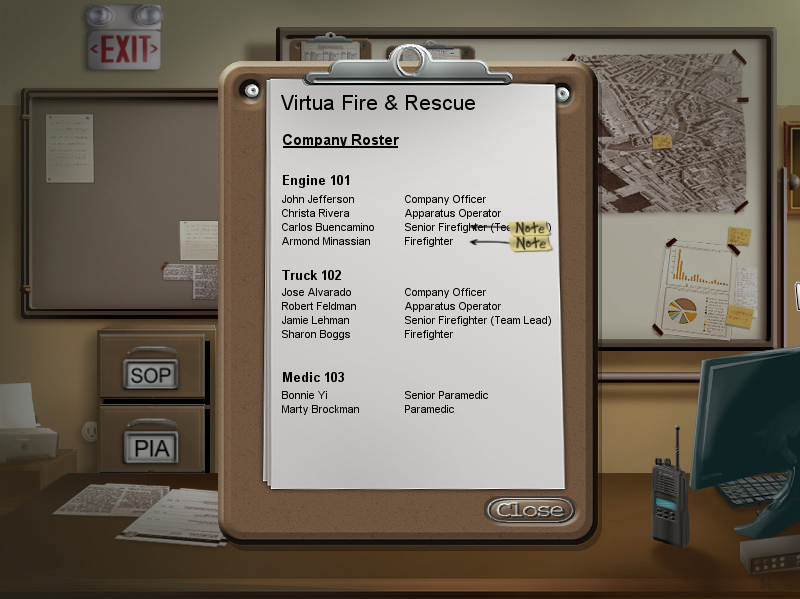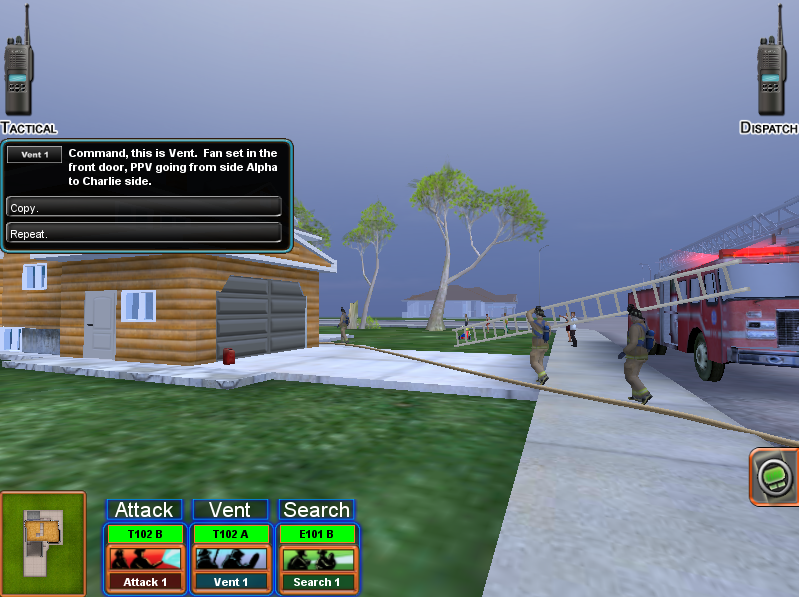Introduction
Fully Involved is a 3D training simulation developed in partnership with the Western Fire Chiefs Association that is designed as an instructional aid for firefighter company officers, where users role-play as an incident commander during basic firefighting operations.
Below is a detailed analysis of this game roughly following Brian Winn's1 Design/Play/Experience framework, including:
Learning
Fully Involved is an incident command training simulation for firefighters. The basic intended learning outcomes include:
- Following procedures for fighting a single family dwelling fire
- Establishing and maintaining authority
- Understanding the importance of doing a size-up ("walk-around")
- Maintaining clear communications with other firefighters
- Making decisions under stress
- Responding to hazards faced with fighting a fire
- Minimizing freelancing
- Keeping unfit firefighters off duty
Storytelling
In Fully Involved, you play as company officer that has just come on board with
the Virtua Fire and Rescue Fire Station 1 in the town of Virtua. You meet with
the Battalion Chief (BC) who explains that you will assume the role of incident
commander and respond to various calls. The story does not attempt to completely
immerse the player, with the BC indicating right away that this is just training
and that it will focus only a few specific duties involved in fighting fires.

The importance of the BC goes beyond just introducing you to the game. He will walk
you through the tutorial and serve as a coach during the first few scenarios. The
BC's role employs a degree of fading; as the player progresses to more difficult
levels the BC gives less feedback on their performance.
Gameplay
The gameplay in Fully Involved mostly involves commanding an incident involving
a single family dwelling fire. There are several levels, including a tutorial,
that all involve the same house, but get progressively more challenging. The game
makes extensive use of shaping, with each level adding a new challenge or danger.
Prior to each level, the player can review the company roster and equipment and
weather reports. The roster will show players if there are any team members that
are unfit for duty, and the player will have a choice to send them home. From here
the player can also view the SOP (Standard Operating Procedures), which will open
an HTML page in a new window so players can review them at any time. The SOP provides
additional instruction for the game as well as additional information that firefighters
can use in the real world.

When the player first arrives at an indicent, they can see the burning house and people
gathering outside while your firefighting teams stand by for orders. The first thing the
player should do is a full walk-around of the house to identify any hazards and or other
variables that may effect how they procede. For example, in the tutorial level, doing a
walk-around reveals that there is a little girl trapped in the upper floor of the house.
If there is a confirmed victim in the house, the player should immediately send a team in
to search for them, otherwise the player should wait until the fire is under control before
conducting a search.
Throughout the incident, the player must issue orders to each of the two man teams under
their command as well as continue to query the teams of their status, and to respond to
any issues that come up. When the player first arrives, they only have a few teams to
work with, and more teams eventually arrive as the incident unfolds. Using their limited
resources, they must assign tasks to their teams in order to control the fire, put it out,
then conduct a primary and secondary search. The scenario ends when these objectives have
been accomplished, however the player must also assign some teams to other tasks in order
to allow these objectives to be met. The player also has to keep track of each team's status
to make sure that they are safe and that they are doing what they're supposed to.

In the first few levels these tasks are easy enough to perform, but as the levels get harder
the game throws more unexpected variables at the player. While there's a procedure for each
of these, the player can quickly become overwhelmed and either forget to perform a specific
action or choose an inappropriate action to take. In addition to following the procedures,
the game tests the player's decision making abilities in stressful conditions. If the player
does mess up, the level will usually end in failure. When the player successfully completes
the objectives, they are scored on their performance. If their score is too low, they must
complete the level again before proceding to the next.
User Experience
All of the interaction in Fully Involved is done with a mouse. The player can click and drag
the mouse to look around in the 3D game world and click on buttons on a 2D map of the premesis
to move around the house. The ability to look around in the world is important to the gameplay
because there are times when the player needs to respond to things they see. For example, if
they see a victim in the house or if a firefighter passes their vision without proper equipment.
There is only one keyboard command that I could identify, and that is the use of the Esc key to exit
the scenario.
There is a minimap of the building located in the bottom corner of the screen which the player
clicks on to enlarge. The map has different layers showing each level of the building, and also
indicates where the hazards and firefighter teams are. The teams can be commanded by clicking
on their respective icons on the bottom of the screen and selecting orders from a list. There
are two radio icons on either side of the screen that the player uses to issue further communications.
Throughout the incident, radio messages appear as text that pops up on the side of the screen and
usually give the player the option to reply with "Copy" or "Repeat". The interface is not very
transparent in a technical sense, but it does not really break the immersion and it does a good
job of facilitating the gameplay.

The sounds in the game are also important. While most of the radio messages will appear on screen
as text, when there are a lot of incomming messages the text often cannot keep up and the player
has to listen for the messages. The sounds also serve the purpose of making the experience more
convincing. There are background sound effects of the running equipment, the burning fire, and
the chatter of the people that gather to observe.
Technology
Fully Involved makes use of the Torque 3D game engine. The graphics seem a bit dated, but the importance is in the simulation of the procedures. The use of a 3D envirnoment is critical since realism and immersion are necessary to serve the learning goals. The game can be used on any typical windows computer, and does not require high-end hardware, keeping the game quite portable. The SOP data also features HTML.
Assessment
I could not find any formal assessment of Fully Involved, and surprisingly the course text2
does not mention anything about how, if at all, Fully Involved was assessed despite it being one of the primary
examples used throughout the book. A pre- and post-test may be effective, but since the game already has a built-in
assessment of the player's performance, it may be reasonable to speculate that the developers already conducted a
formal pre- and post-test assessment in order to develop the performance metrics.

Perhaps a more reliable method, though more costly, would be a classroom or role-play assessment. Many of the skills
the game aims to teach are procedural, and can thus be demonstrated in a classroom or role-playing environment. The
use of role-play could further evaluate the decision making under stress and communication factors.
Conclusion
Fully Involved does an adequate job of acheiving its intructional goals. The experience is quite enjoyable, and
the simulation is immersive enough to convey the stressfulness of the situation. For firefighters it seems like it
could be an invaluable training tool. For players who are not familiar at all with firefighting, it starts to
get quite challenging, but the game will force you to learn the procedures in order to be successful.
There were a few minor issues that I encounted while trying to follow the tutorial that seemed like bugs, but I
was able to continue. During the later levels, as the BC offers less feedback, I found it became difficult to
figure out what I was doing wrong, or how to correct it. However, consulting the SOP helped a bit and presumably
being a firefighter would give you the prerequisites to have a better understanding of what to do in those
situations.